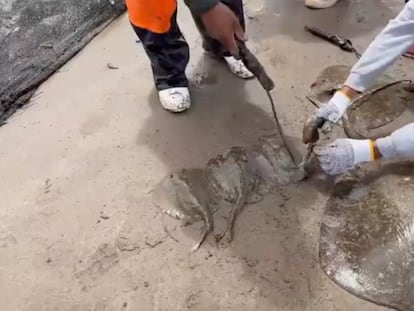The Mexican women breathing new life into Yucatán’s mangrove forests
‘Las chelemeras’ — a group of 18 women of Mayan origin from the same fishing village — have spent more than a decade journeying into the swamps, protecting and regenerating various ecosystems
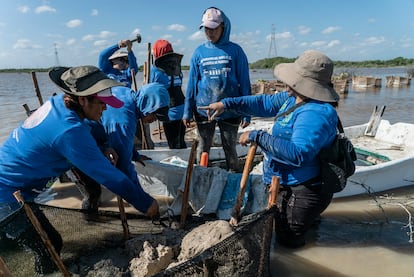
In a state reserve on the Yucatán Peninsula, in southern Mexico, eight women work under the sun. While two of them push a wooden boat loaded with heavy sacks of mud and sediment through the swamp, the rest split up into pairs, sewing and spreading out the tarquinas — hand-woven meshes — about two feet from each other in the middle of the mangroves.
This is an artisanal yet sophisticated system, by which several wooden sticks are propped up with a hammer. These sticks will serve as support for the nets, into which the women will pour the mud. Days later, when the mud is settled, they will carefully plant red mangrove seeds.
For 13 years — and with a lot of patience — this group of 18 women (between the ages of 27 and 84) have built a mangrove barrier on the northern coast of Yucatán. This project is helping to recover ecosystems that had been lost due to environmental degradation and urban development.
Las chelemeras — as they are known, for these women of Mayan origin hail from Chelem, a small fishing village — have helped restore the mangrove forests. These forests have the ability to slow the rising sea levels, especially when hurricane season hits, and capture large amounts of carbon dioxide.
“Here, when we get [busy], we forget about the world,” says Keila Vázquez, in a carefree tone. Aged 43, she is the leader of the group.
Each morning, the women head into the swamp and gather beside the canoe trail in the city of Progreso, awaiting instructions from Vázquez. They are outfitted in hats, gloves, blue T-shirts (with the outline of the restoration project printed on them) and shorts over skintight leggings that are tucked inside shiny rain boots to keep out the mud.
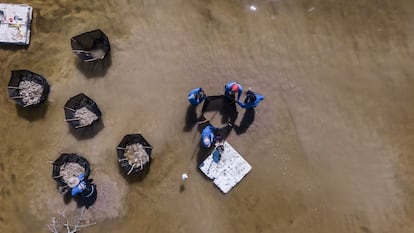
For the group, the leadership of this calm woman — who is less than five feet tall — is unquestionable. Without raising her voice, in a sweet tone and Yucatecan cadence, dragging out the vowels, she tells them the day’s plan: “Right now, we’re in this part here,” says Vázquez, pointing to the drawing on the T-shirt of one of her companions, which represents the different depths of the mangrove that they are restoring. “It’s the second stage… make some tarquinas so that the part that is deepest lines up,” she tells them.
“At other points in time, we’ve done different tasks, such as [digging] water channels. There was no water before — it was a dry place,” she explains.
In the decade that they’ve been working in this area, Las chelemeras have managed to restore more than 60% of the state reserve of swamps and mangroves on the north coast of Yucatán, according to biologist Claudia Teutli. Next to the canoeing track — where the elderly women weave the nets — there’s a sign that reads, “91.2 hectares of restored vegetation as a habitat for more than 70 species of birds.”
“The resources haven’t been consistent,” Teutli admits. “But we’ve still had a 60% success rate. There are image analyses in which you can see how the vegetation cover has increased. I think that, by now, it should be more, because it’s worked quite well.”
A doctor in environmental sciences and technology from the National School of Higher Studies of Mérida, Teutli has accompanied Las chelemeras, alongside Dr. Jorge Herrera, from the Center for Research and Advanced Studies in Mexico City.
“Today, [these women] are biologists, ecologists… they understand the hydrological processes and the plants,” says Dr. Teutli.
Their work provides a lesson for the entire community. When Las chelemeras return home, they teach their families the importance of caring for the environment, trying to raise awareness among their neighbors. But it wasn’t always like this.
Although their project is now a benchmark in Mexico — which contains the fourth-highest amount of mangroves in the world — before entering the swamp, the voice of these women went unheard.
“As housewives, they didn’t contribute to the family economy. Now, [environmental] restoration actions are part of their way of life,” Teutli says. “They contribute economically to their families. They’ve changed the perception that women cannot work and have transmitted their knowledge in a 13-year-long process. [Today], some of their sons and daughters are pursuing university degrees related to ecology.”
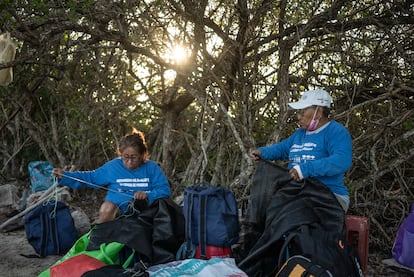
Las chelemeras came to the mangroves by chance. Before, they say, they weren’t even aware of the importance that the forests had for biodiversity — they lived with their backs to them. But in 2010, when the local authorities offered new job opportunities to help restore the mangroves, fishermen were in high demand.
The government thought, the women recall, that the men would be better-suited for long days in the sun, in swampy terrain that can swallow you knee-deep as you walk. But the work conditions that were initially offered — a minimum wage of just over 60 pesos, or $3 — didn’t appeal to their husbands. So, the wives of the fishermen decided to step forward.
Today, not only have they managed to carry out a powerful project, but sometimes, when the waters are stormy or the catch is low, they bring home more money than the men.
It wasn’t easy at the beginning. “Sometimes, when the group traveled by public transport after doing the work here, [people] would make faces at them, because of the smell of mud and because the community was unwilling to work here. But now, [the attitude] has changed,” Vázquez acknowledges. The residents of the coastal towns eventually saw the radical transformation taking place in the swamps.
“Before, it was a dirty, ugly fjord,” says Regina Chim Batún, one of the oldest in the group, when she recalls the first mangrove swamp that they regenerated in Yucalpetén, just over three miles from the one they are currently restoring. Disorderly urban development led to the construction of infrastructures that cut off the natural flow of water from the swamps. Sometimes, the local populations even used the swamps as a dump. This brought about the end of life in the ecosystem. But now, thanks to the restoration, there are, once again, dozens of species of birds, fish, mosquitoes… even flamingos and lizards. In fact, when they leave the mangroves, Las chelemeras take bags of chivita snails, with which they can make a ceviche for dinner.
To achieve this transformation, a forensic ecology process was carried out — or the “CSI of the mangroves,” as Teutli calls it. She’s a big fan of the crime show.
“You have to identify the causes of why [the ecosystem] died,” she explains. “We have to evaluate how the vegetation is, how the hydrological flow is, the topography... all those components that are essential for the system to work.”
Once the problem is identified, the actions to be taken are determined, which can range from regenerating optimal conditions for the mangrove, to reviving reforestation processes.
“When conditions improve, the ecosystem responds on its own. Reforestation, for us, is the final action in the regeneration process,” the biologist says.
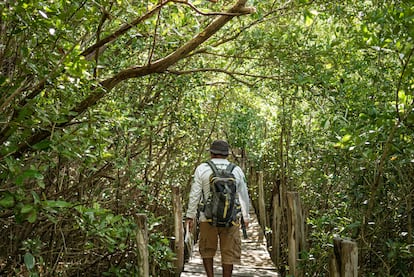
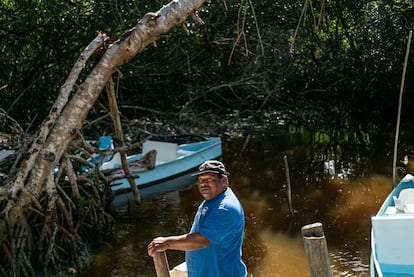
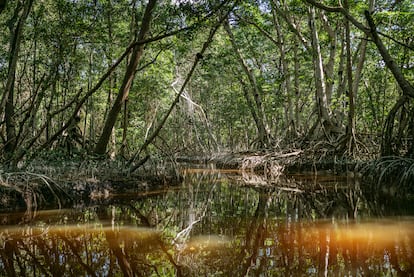
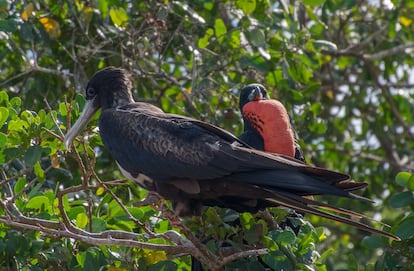

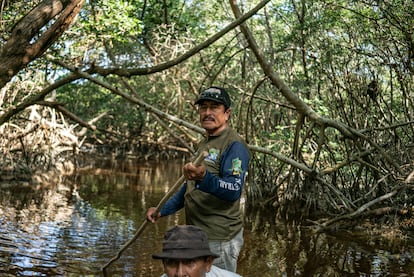
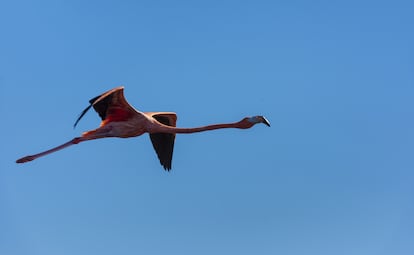
![Tour guide Efraín Pérez always insists on making visitors aware that they must protect the mangroves. "They must be aware and appreciate that it offers ecosystem benefits, such as being a barrier against hurricanes. It’s [also] a fish hatchery area, a refuge for birds and flora. It can also absorb carbon dioxide... more than the rainforests!"](https://imagenes.elpais.com/resizer/v2/BQICRFH3VFEN3OIDUCDL6FZBY4.jpg?auth=a38aa355fcd080a0b33402c4e78b374f9e923daeec6e6b1a7879940af7a8e6a4&width=414)

![Tour guide Efraín Pérez points out one of the mangrove trunks along the path. Tourists walk past it on foot, before getting into the canoes. "What most attracts [people’s] attention is the height of the mangroves. And the tranquility when entering the tunnel. Some tourists close their eyes to enjoy the sound.”](https://imagenes.elpais.com/resizer/v2/ZV3Z4YYXUFGKLEZHLC5VV3RRMA.jpg?auth=639e26069b76ca10a93bc8596be74b710d6c443313e0b8256c95596e53033edc&width=414)
Las chelemeras haven’t overseen the only successful mangrove regeneration project on the north coast of Yucatán. There are other groups in coastal towns — such as Celestún, Dzilam or Sisal — that have carried out similar processes. However, this is the only operation that is made up entirely of women and has become the local area’s benchmark.
“The success at the social level has been that they have passed on the knowledge to others… there is more respect for the mangrove, because before, [locals] saw it as a garbage dump,” explains Teutli. And, while they have made huge gains in the restoration process — partly with resources obtained through governmental compensation, or thanks to international cooperation — Las chelemeras are already thinking of alternative methods to finance themselves, such as the production of black mangrove honey and ecotourism.
Teutli also highlights the “impressive” level of organization of the group. “They insisted that older people be given work, [even though] some funders view it badly, because they believe they should be resting. But we’re in a country where, unfortunately, not everyone has a pension,” she explains. The group decided that the younger ones would do the most physically demanding work, while the older ones would help with the less strenuous tasks.

On the shore, the four elderly women who knit the tarquinas share their love for what they do. “At 71, I’m still working. There’s a lot of work, thank God. We like to work and have fun. You forget [your thoughts] and you de-stress,” says Regina Chim Batún. “This is how we’ve managed to get ahead a little bit. Sometimes, visitors come and ask us how we do it: [they tell us] how beautiful [the mangroves] are, how green, how nice that we plant them,” she says proudly. She reveals that the secret to their work is to “have a lot of patience.”
Before working in the mangroves, Chim Batún was a street vendor. “I used to make my pork rinds, my corn, my apples, my popsicles, coconut pies, cheese pies, coconut cream, blancmange.” She continues to make food on the weekends but her daughters are now the ones who go out and sell.
For her, taking care of the mangroves is like taking care of another child. That’s why it bothers her so much when she sees that some communities mistreat them, or use them as a dump.
“How do we want to see our children? Watching them grow, supporting them, caring for them... a plant is like a child. If you come and step on it, what can you do? You already managed to plant it and then [someone] comes and disrupts it,” she laments.
For Vázquez, the greatest satisfaction is seeing the mangroves grow. But also seeing how, thanks to their efforts, Las chelemeras — women who were mostly housewives without higher education before joining — have managed to change their lives. “Seeing that your work has a non-economic value, that it has importance, that you are leaving a little bit of a mark on this world, makes us feel proud.”
When she’s not in the mangroves, Vázquez is usually in charge of a grocery store in Chelem. She is also the mother of three children between the ages of 18 and 23. One of them is studying biology and thinks she can follow in her mother’s footsteps.
Because of her position as leader of the group, Vázquez is often at working meetings with scientists, attending to the press, or receiving awards in Mexico City. She has noticed how the work in the mangroves has also changed her relationship with her family.
“Before, I would ask my husband for permission to go out. Now, I just let him know. We are empowered.”
Sign up for our weekly newsletter to get more English-language news coverage from EL PAÍS USA Edition
More information

